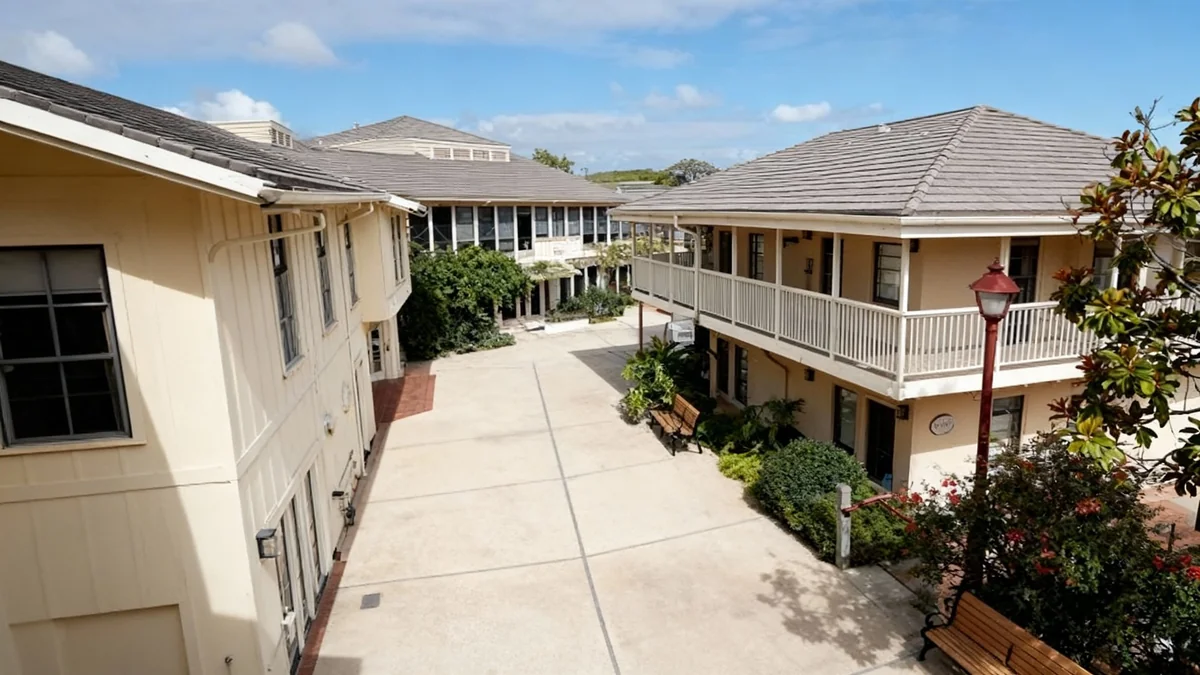Heritage Harbor, a quiet office park along Monterey's scenic Rec Trail, stands as a testament to complex urban planning and historical preservation challenges. Many daily passersby overlook its unassuming presence, yet its location on prime coastal real estate has long raised questions about its origins and purpose.
Recent insights into its past reveal a surprising story involving urban renewal efforts, the displacement of lower-income residents and businesses, and a continuous struggle to balance development with strict historic preservation laws in Monterey.
Key Takeaways
- Heritage Harbor, originally envisioned as a bustling shopping mall in the 1980s, is now a quiet office park owned by the Monterey Bay Aquarium.
- Its development involved an urban renewal project that led to the displacement of lower-income residents and businesses.
- Monterey faces ongoing challenges in balancing new development with stringent historic preservation laws.
- The area's history highlights the complex interplay between economic development, community impact, and historical context.
The Unseen History of Heritage Harbor
For decades, Heritage Harbor has been a somewhat invisible landmark in Monterey. Situated near the Wharf and Cannery Row, it occupies a significant spot along the waterfront. Despite its central location, its current function as an office park often feels out of place with the vibrant tourism and historical character of the surrounding area.
The site's journey began with grander ambitions. In the 1980s, plans called for a dynamic shopping mall. This vision, however, never fully materialized, leading to its eventual transformation into the office park seen today. The Monterey Bay Aquarium now owns the property.
Did You Know?
Heritage Harbor was originally planned as a bustling shopping mall in the 1980s, but the project ultimately failed to thrive in that capacity.
Urban Renewal and Community Impact
The establishment of Heritage Harbor was part of a broader urban renewal initiative in Monterey. While these projects often aim to revitalize areas, they can come with significant social costs. In this case, the development led to the displacement of various lower-income residents and small businesses.
These actions were undertaken to make way for waterfront development and to preserve certain historic buildings. The balance between progress and community well-being is a constant challenge in urban planning, especially in historically rich areas.
"The story of Heritage Harbor reveals the difficult choices cities sometimes make in the name of progress, and the lasting impact on their communities."
Navigating Historic Preservation Laws
Monterey is renowned for its rich history and numerous historic buildings. This heritage is protected by strict preservation laws designed to maintain the city's unique aesthetic and cultural tapestry. While crucial for conservation, these laws also present significant hurdles for new development projects.
Moving forward, navigating these regulations will remain a key challenge for any construction on the waterfront or in the downtown area. The city must find ways to evolve while respecting its past.
A City's Dilemma
Monterey's historic preservation laws are designed to protect its unique character. However, they frequently create obstacles for new construction, including much-needed affordable housing projects, as seen with a recent hold-up on 41 units behind City Hall.
The Ongoing Debate: Evolution vs. Preservation
The experience of Heritage Harbor highlights a critical question facing Monterey: Can the city embrace future growth and development while still adhering to its rigorous historic preservation mandates? This tension is evident in ongoing debates about new projects, including affordable housing initiatives.
For example, a proposed 41-unit affordable housing complex behind City Hall has faced delays due to the historic nature of its neighborhood. This situation underscores the complexity of balancing modern needs with the desire to maintain historical integrity.
- Economic Development: How can Monterey attract new businesses and residents?
- Housing Affordability: How can the city provide more housing options for its diverse population?
- Cultural Heritage: How can historic sites be protected without stifling growth?
These questions are not unique to Monterey, but they are particularly pronounced in a city with such a strong historical identity and valuable coastal land. The path forward requires careful planning, community engagement, and innovative solutions.
Lessons from the Waterfront's Past
The narrative of Heritage Harbor serves as a powerful reminder of the long-term consequences of urban planning decisions. What was once envisioned as a vibrant commercial hub became a quiet office park, reflecting the challenges of large-scale development in a historically sensitive area.
Some observers suggest that bad planning, rather than a curse, ultimately doomed the original vision for Heritage Harbor. Fifty years on, the site continues to prompt reflection on how cities can best utilize prime real estate while honoring their past and supporting their communities.
The story of Heritage Harbor is not just about a building; it is about the evolution of a city, the impact of policy on people, and the ongoing effort to define what progress truly means in a place deeply rooted in history.





